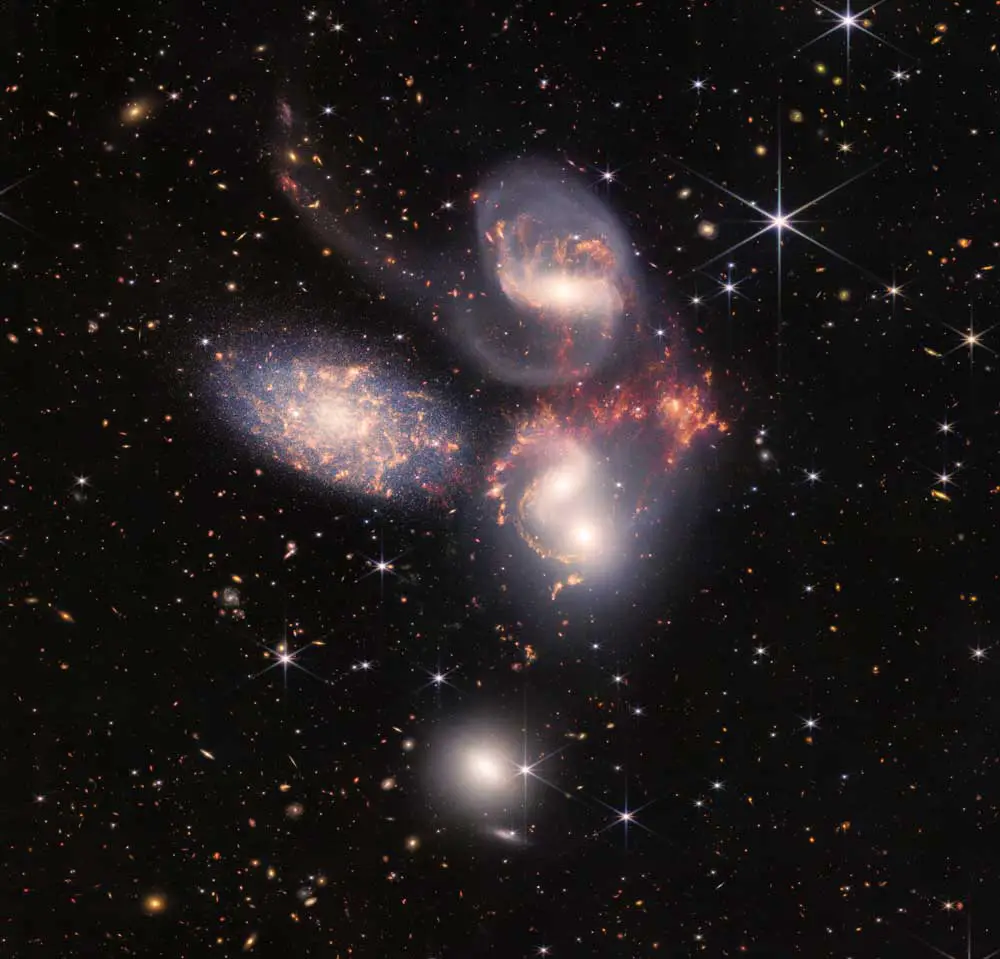
By Silas Laycock
The James Webb Space Telescope team has released the first science-quality images from the new telescope. In them are the oldest galaxies ever seen by human eyes, evidence of water on a planet 1,000 light-years away and incredible details showing the birth and death of stars. Webb’s purpose is to explore origins – of the universe, of galaxies, of stars and of life – and the five images released on July 12, 2022, make good on that promise.
Once the suite of instruments onboard all cooled down and were running smoothly, astronomers wasted no time in putting Webb to work. Each of the first images contains enough data to produce major scientific results on their own.
Webb was designed to collect light across the entire red to mid-infrared spectrum – wavelengths of light that are blocked by Earth’s atmosphere. And with its giant mirror and sun-shade blocking infrared emitted by the Sun, Earth and Moon, Webb can produce images of a sharpness never before achieved by any other telescope.
The buzz among professional astronomers like me has been electric since members of the Webb team shared tantalizing test images. And the real images are even better than anyone could have hoped for. During the presentation where the first images were released, Webb project scientist Jane Rigby remarked “for Webb there is no blank sky, everywhere it looks it sees distant galaxies.” Most of those galaxies were invisible until now.
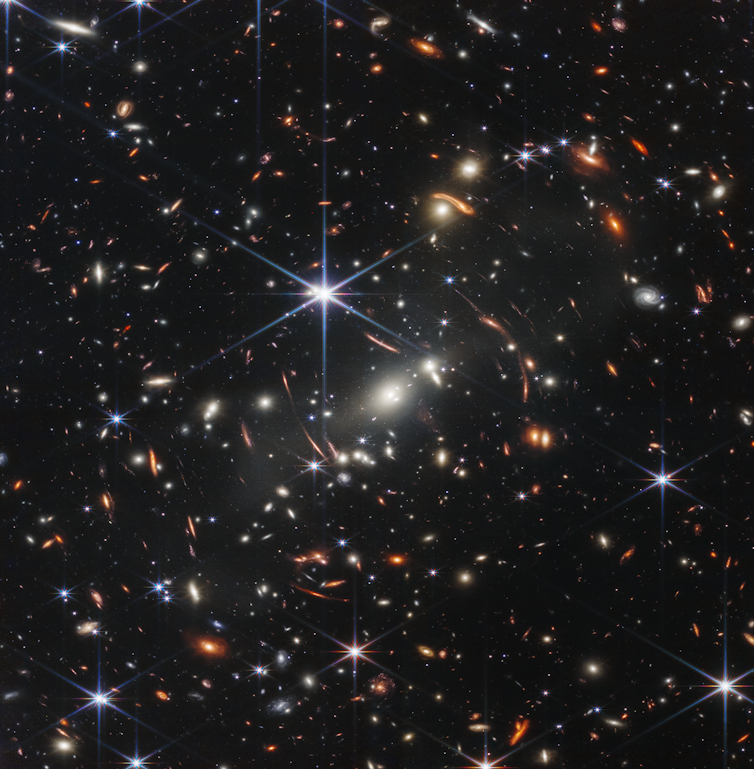
NASA/STScI
Ancient galaxies and the early universe
The first Webb image the world saw is of a galaxy cluster known to astronomers as SMACS 0723. It lies in the southern hemisphere sky and is 5.12 billion light-years from Earth.
The detail of the thousands of individual galaxies in the image is stunning. It is like the universe in high definition, and I encourage you to look at the full resolution image and zoom in to truly appreciate the details.
The large white galaxies in the middle of the image belong to the cluster and are similar in age to the Sun and Earth. Surrounding and interspersed among the cluster galaxies are more distant galaxies, but stretched into spectacular arcs as if seen through a magnifying glass. And that is exactly what is happening. The background galaxies are much farther from Earth but appear magnified, as their light is bent toward Earth by the gravity of the much closer cluster.
In the background you can see faint red galaxies scattered like rubies across the sky. Those galaxies are even farther away. By measuring precise attributes of their light, astronomers can tell that they formed over 13 billion years ago and even determine the abundance of different elements in these early galaxies.
Webb is not only producing incredibly sharp images, but it is doing so easily when compared to its predecessor, the Hubble Space Telescope, which was launched in 1990. As Rigby quipped, “… the Hubble Extremely Deep Field took two weeks of exposure, Webb went deeper before breakfast.” Once Webb carries out longer observations that allow it to collect more light from faint stars or galaxies, astronomers will be able to see some of the first stars and galaxies that formed right after the Big Bang.
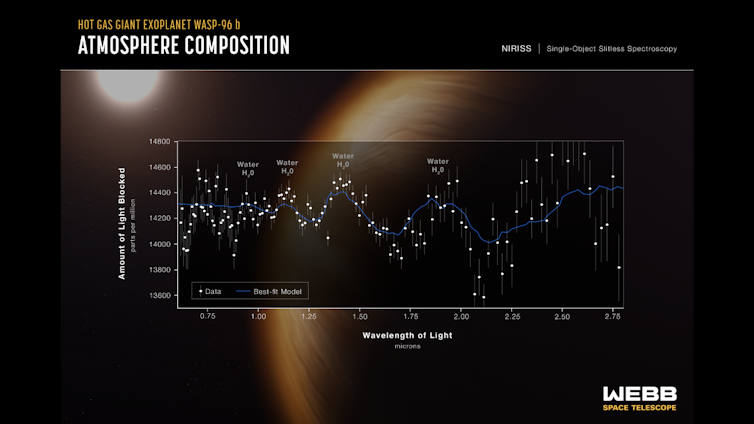
NASA/STScI
Understanding planets around other stars
The second reveal was not of an image but a spectrum – a breakdown of the strength of light at different wavelengths.
Webb pointed its mirror at the exoplanet WASP 96-B – a giant hot gas planet orbiting a star about 1,000 light-years from Earth – as the planet passed in front of its parent star. During this transit, a portion of the star’s light was filtered through the planet’s atmosphere and left a “chemical fingerprint” in the light’s unique spectrum. The specifics of this fingerprint strongly suggest that there is water vapor, clouds and haze in the atmosphere of WASP 96-B.
As Webb moves on to observe smaller planets that could potentially harbor life, astronomers expect to detect the fingerprints of oxygen, nitrogen, ammonia and carbon in the form of methane and other hydrocarbons. The goal is to find biosignatures of life – that is, chemistry that would point toward the atmosphere being modified by living organisms.
The technical challenge of doing this type of observation, called transit spectroscopy, is enormous, and this initial result barely scratches the surface of the scientific content of the spectrum.
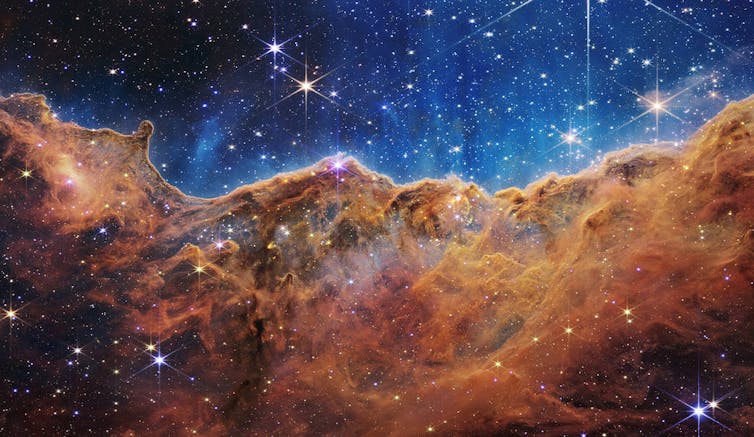
NASA/STScI
Galactic dances and the lives of stars
The last three images showed the incredible resolution of Webb’s optics as the telescope explored the birth and death of stars.
Webb’s ability to capture light in the mid-infrared range allows its cameras to cut through dense clouds of dust and gas. This ability helped Webb to capture spectacular details of the Carina Nebula where stars are born.
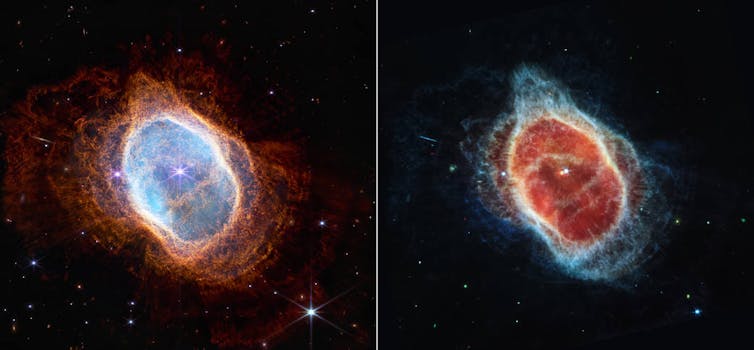
NASA/STScI
Webb is also excellently suited to study the end of a star’s life. As stars get old, they can puff off their outer layers and form nebulas like the stunning Southern Ring Nebula, which was imaged by Webb. The image revealed never-before-seen details of successive waves of matter expelled by the dying central star. While Hubble was unable to see through the expanding cloud of dust and debris, Webb provided the first look at the binary star system that formed the nebula.
The last photo from Webb’s coming out party showed Stephan’s Quintet, a group of five galaxies 300 million light-years from Earth, interacting in a cosmic dance. Thanks to the suite of complementary instruments aboard Webb, the telescope can simultaneously pick up details of individual stars in these galaxies, see the cold dust and gas fueling star formation within these galaxies and – most remarkably – block out the stars, gas and dust to see the material swirling around the supermassive black hole at the center of one of the galaxies.
Webb also captured data on the spectra of hundreds of individual star-forming regions in the Quintet, which will take months to analyze and study.
Webb is the result of 25 years of work by thousands of scientists, engineers and administrators belonging to an international collaboration of space agencies, companies, research centers and universities worldwide. John Mather, a project leader for Webb, emotionally described the journey: “This was hard to do. It is difficult to express just how hard this was. There were so many thousands of ways it could have gone wrong.”
But it didn’t go wrong. It all came together, and now humanity’s greatest space telescope is open for business.
![]()
Silas Laycock is Professor of Astronomy at UMass Lowell.


























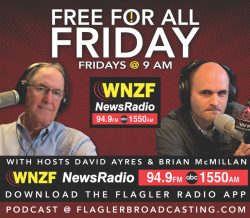

Jane Gentile-Youd says
Millions of our dreams have come true; my father’s dream has come true. ” We are infinitesimal specks and thanks to the incredible work of these amazing people like John Mather and his devoted colleges we are blessed to be able to see how far back in time we ‘specks’ came from. The most breathtaking photos ever seen by mankind. I am blessed to be alive to see them. ( Not that it matters buy hubby and my very first date in 1990 was standing on a bridge in Cocoa Beach watching the Hubble take off – we left Miami too late to get to Titusville that morning)..